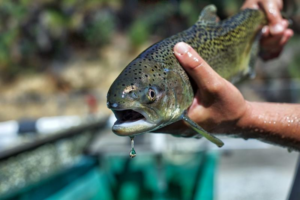- Confirm that two functions are inverses
- Figure out the allowed inputs and outputs for an inverse function and adjust the original function’s domain to ensure it is one-to-one
- Discover or calculate the inverse of a function
- Draw the inverse of a function on the same graph by reflecting it across the line [latex]y=x[/latex]
The Chinook salmon, a vital species in California’s ecosystem, faced a critical threat of extinction. To protect these remarkable fish, conservationists launched an ambitious reintroduction program in California’s Central Valley.[1]

The project centered on releasing juvenile Chinook salmon into a tributary of the Sacramento River. By monitoring the number of adult salmon returning to spawn each year, scientists could track the program’s success and the species’ recovery.
Scientists collected data about the relationship between the number of juvenile salmon released and the number of adult salmon that returned to spawn. This relationship can be modeled using a function [latex]f[/latex], where [latex]f(x)[/latex] represents the number of returning adult salmon when [latex]x[/latex] thousand juvenile salmon are released.
Using this model, biologists can better understand:
- How many juvenile salmon they need to release to achieve their target adult population
- What factors might be affecting the survival rate
- How to optimize their conservation efforts
The function [latex]f[/latex] models how juvenile salmon releases ([latex]x[/latex] thousand fish) relate to returning adult salmon ([latex]f(x)[/latex]). However, biologists often need to work backward – if they want a specific number of adult salmon to return, they need to calculate how many juveniles to release.
This is where inverse functions become valuable. The inverse function [latex]f^{-1}[/latex] helps determine how many thousand juvenile salmon need to be released to achieve a target number of returning adults.
- https://www.fisheries.noaa.gov/feature-story/endangered-winter-run-chinook-salmon-increase-millions-offspring-headed-sea ↵